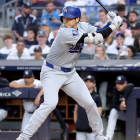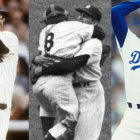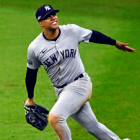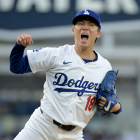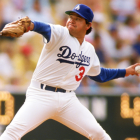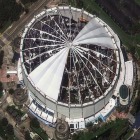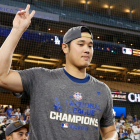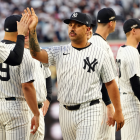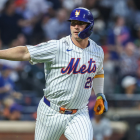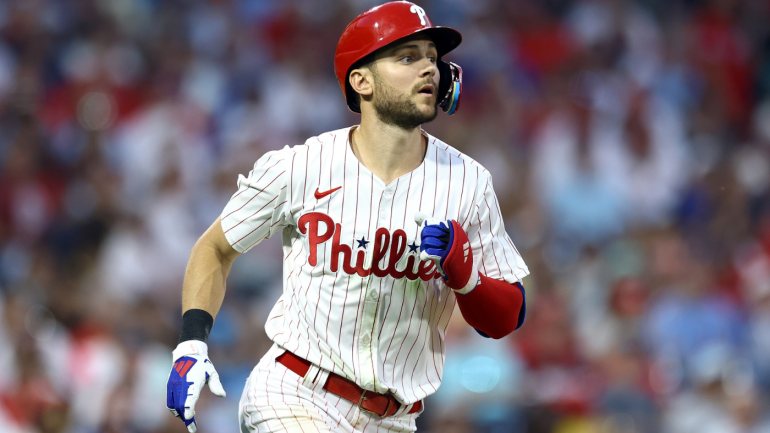
Major League Baseball's annual amateur draft begins this Sunday and future All-Stars and award winners will hear their names called. Maybe even a future Hall of Famer or two. MLB's draft is not about instant gratification -- even the very best prospects will disappear into the minors for a few years -- but you must draft well to be a successful organization. It is imperative.
The 2024 draft class will be evaluated instantly based on what we know right now. And, based on what we know right now, we can go back a decade and evaluate the 2014 draft class. That draft has not yet produced an MVP or a Cy Young winner, but it has produced several All-Stars and World Series champions. Four first-round position players have appeared in 500 MLB games, and six first-round pitchers have made 150 MLB appearances.
The 2014 draft did, however, produce one slam dunk future Hall of Famer: Patrick Mahomes. The Tigers selected the two-time NFL MVP and three-time Super Bowl champion out of his Texas high school with their 37th-round pick. Mahomes, whose father Pat played 11 years in the big leagues, did not sign with the Tigers and went on to bigger and better things on the gridiron.
With the infallible benefit of hindsight, we're going to go back and "redraft" the 2014 first round. To be clear, this is not a straight ranking of the best 2014 draftees by WAR or something like that. That would be boring. We're redrafting players based on what they've done in their career to date as well as what we expect them to do in the future, so it's a little more nuanced.
Here now is our 2014 first-round redraft, beginning with one of the most electrifying players in the game today.
1. Houston Astros: SS Trea Turner, NC State
Actual pick: LHP Brady Aiken, Cathedral Catholic HS (California)
Turner's draft slot: No. 13 (San Diego Padres)
Turner and San Francisco outfielder Bradley Zimmer were considered the two best college position players in the draft class. There were questions about Turner's power potential and whether he'd remain at short, plus he had an up-and-down draft season at NC State, but he developed into a star and one of the most dynamic all-around players in the sport. He was the NL Rookie of the Year runner-up in 2016, he's been to two All-Star Games, he's received MVP votes in three seasons, and he helped the Nationals win their first World Series in 2019. Turner is still very much in his prime too, with more production on the way.
The Padres selected Turner with the No. 13 pick on June 5. GM Josh Byrnes was fired on June 22 and A.J. Preller was hired on Aug. 6. Preller traded Turner to Washington as part of the three-team Wil Myers/Steven Souza trade with the Rays on Dec. 17. At the time, players could not be traded within one year of signing their first pro contract. The loophole was players could be traded after six months as a player to be named later. Players to be named have to be named within six months, so you could trade him as a player to be named six months after signing, then actually name him six months after that.
Turner was a player to be named in the Myers trade and he spent the first few months of 2015 as a Padres minor-leaguer knowing he was going to the Nationals as soon as they reached the one-year anniversary of his contract. It was an awkward situation for all involved. Soon thereafter MLB changed the rule, and now players can be traded six months after signing their first contract. The best recent example is Dansby Swanson. He was the No. 1 pick in the 2015 draft and the Diamondbacks traded him to the Braves that December. The Turner trade led directly to a rule change.
As for Aiken, he was the consensus No. 1 prospect heading into the 2014 draft. The Astros took him and the two sides reportedly agreed to a $6.5 million signing bonus, but during his pre-signing physical, Houston saw something they didn't like in Aiken's elbow, and reduced their offer to $3.1 million. That number was important because it was 40% of the $7.9 million slot value, which is the minimum offer required to receive a compensation draft pick the next year if you failed to sign a player. Ultimately, Aiken did not sign. He is one of only three No. 1 picks not to sign, joining Danny Goodwin (White Sox in 1971) and Tim Belcher (Twins in 1983).
But wait! There's more. The Astros planned to use the savings from Aiken's pick -- the $6.5 million bonus was below the $7.9 million slot value -- on righty Jacob Nix, their fifth-round selection. They reportedly agreed to a $1.5 million bonus with Nix, well above the $370,500 slot value for his pick. Once Aiken did not sign, the Astros lost the bonus pool money associated with his pick, and they reneged on their deal with Nix. They no longer had the bonus pool money to pay him.
"Today, two young men should be one step closer to realizing their dreams of becoming Major League ballplayers," MLB Players Association executive director Tony Clark said in a statement after the 2014 draft signing deadline passed. "Because of the actions of the Houston Astros, they are not. The MLBPA, the players and their advisers are exploring all legal options."
The MLBPA filed a grievance on Nix's behalf and the two sides settled in December 2014. He received the full $1.5 million. Nix re-entered the draft in 2015 and was a third-round pick by the Padres. He reached the big leagues briefly in 2018 and was active in Japan last season. Aiken had Tommy John surgery in March 2015. Cleveland took him with the No. 17 pick that summer and paid him a $2.5 million bonus. Aiken battled injuries in the minors and never got past Single-A. He's been out of baseball since 2019.
Despite not signing the No. 1 pick and botching things with Nix, it all worked out in the end for the Astros. They received the No. 2 pick in 2015 as compensation for failing to sign Aiken as the No. 1 pick in 2014, and they used that pick on Alex Bregman.
2. Miami Marlins: RHP Aaron Nola, LSU
Actual pick: RHP Tyler Kolek, Shepherd HS (Texas)
Nola's draft slot: No. 7 (Philadelphia Phillies)
Nola was the stereotypical "safe" college starter at LSU. He stood out for his fastball command and aptitude, two traits that helped him reach MLB barely a year after being drafted. The Phillies helped Nola fine-tune his arsenal and delivery, and he has pitched at an ace level or something close to it for most of the last decade. Nola has almost double the career WAR of any other pitcher drafted in 2014. He hasn't shown any signs of slowing down either.
These days teams steer clear of high-school righties because there's so much risk, and Kolek at the time was an arm strength guy. He'd hit 100 mph several times his senior year, but everything else about his game was lacking (secondary pitches, command, etc.). Kolek had injuries and was ineffective in the minors. He never played above Single-A and has been out of baseball since 2019. MLB's draft has been around since 1965, and 2014 is the only year both the No. 1 and No. 2 picks failed to reach the big leagues.
3. Chicago White Sox: 3B Matt Chapman, Cal State Fullerton
Actual pick: LHP Carlos Rodón, NC State
Chapman's draft slot: No. 25 (Oakland Athletics)
For all intents and purposes, Chapman became the exact player he projected to be in college. He's a brilliant defender and a power-over-hit offensive player. Chapman, a four-time Gold Glover and one-time Platinum Glover, would get drafted higher today than he did in 2014 because we would be able to precisely measure his power (exit velocity, etc.) and plate discipline. Back then, there was too much attention paid to the things Chapman couldn't do (make consistent contact) than what he could do. Rodón featured one of the best sliders in college baseball history during his time at NC State. Injuries have been a problem throughout his pro career, but, these last four years, he's become the frontline guy he was projected to be on draft day.
4. Chicago Cubs: RHP Logan Webb, Rocklin HS (California)
Actual pick: C Kyle Schwarber, Indiana
Webb's draft slot: No. 118 (San Francisco Giants)
In high school, Webb was just as famous as a quarterback as he was as a baseball prospect. The Giants took him in the fourth round, he had Tommy John surgery in 2016, and he didn't reach the big leagues until 2019. It wasn't until 2021 that Webb finally established himself as an above-average player. He is now one of the best pitchers in the game and has proven to be worth the wait. Schwarber was indeed at catcher at the time of the 2014 draft. He didn't last long behind the plate, but the top of the line power he showed in college has translated well to pro ball. The Cubs don't regret this pick even a tiny little bit seeing how Schwarber helped them win the 2016 World Series after his miraculous return from a torn ACL.
5. Minnesota Twins: C Kyle Schwarber, Indiana
Actual pick: SS Nick Gordon, Olympia HS (Florida)
Schwarber's draft slot: No. 4 (Chicago Cubs)
Schwarber is the "incorrect" pick here based on WAR, but the other top candidates for this slot are pitchers who've had major arm injuries, so I'm going with the player closing in on 300 home runs with a career OPS+ over 120. There is no doubt Schwarber is a flawed player. He strikes out a lot, he doesn't hit for average, and he's a terrible defender. Because of that, he's topped out in the 2-WAR-a-season range throughout his career. There is still something to be said for being one of the game's top power hitters though. Gordon's athleticism and bloodlines (his father, Tom, and brother, Dee, both played in the big leagues) never translated into consistent production. He's become a role player.
6. Seattle Mariners: RHP Dylan Cease, Milton HS (Georgia)
Actual pick: C Alex Jackson, Rancho Bernardo HS (California)
Cease's draft slot: No. 169 (Chicago Cubs)
It was an open secret leading up to the 2014 draft that Cease needed Tommy John surgery. Elbows are generally fixable and these days that wouldn't deter teams, and Cease would have been a first-round pick. Back then, the injury pushed Cease into the sixth round, where the Cubs paid him a $1.5 million bonus (essentially first-round money). The Cubs sent Cease across town to the White Sox in the Jose Quintana trade at the 2017 deadline, where he's settled in as a very good starter, albeit one who will frustrate you with walks from time to time. Jackson was considered one of the best hitters in the draft and Seattle moved him to the outfield to reduce injury risk and get him to the big leagues quicker. The bat stalled though, and eventually Jackson went back behind the plate to extend his career. He's a journeyman backup/No. 3 catcher type.
7. Philadelphia Phillies: LHP Carlos Rodón, NC State
Actual pick: RHP Aaron Nola, LSU
Rodón's draft slot: No. 3 (Chicago White Sox)
Going into the 2014 college season, Rodón was viewed as a candidate to go No. 1 overall, if not the favorite. He was worked very hard that spring though and his stuff backed up a tad, so once the draft rolled around, there were more questions about him than expected. Rodón still went No. 3 and eventually developed into a top flight starter, albeit not until 2021. The Phillies hit the jackpot with Nola at this pick. They drafted two of the top 10 players in our 2014 redraft, and four of the top 10 are currently on their MLB roster.
8. Colorado Rockies: LHP Jordan Montgomery, South Carolina
Actual pick: LHP Kyle Freeland, Evansville
Montgomery's draft slot: No. 122 (New York Yankees)
Despite an excellent college track record, Montgomery wasn't a terribly exciting prospect on draft day, and the Yankees nabbed him in the fourth round. They helped him improve his curveball and changeup, and also lowered his arm slot a tad to get more sink on his sinker, and he made the big league roster out of spring training in 2017. Since then, Montgomery has been about as reliable a starter as there is in the game. Freeland's draft year at Evansville was ridiculous -- 1.90 ERA with 128/12 K/BB! -- and he's been a steady innings guy stuck playing home games in Coors Field. He's got a $64.5 million contract and he gets to play in Denver, his hometown, so I doubt Freeland has any complaints. Still, I can't help but wonder what he could have become outside Coors Field and with a more competent organization.
9. Toronto Blue Jays: RHP Brandon Woodruff, Mississippi State
Actual pick: RHP Jeff Hoffman, East Carolina
Woodruff's draft slot: No. 326 (Milwaukee Brewers)
A 2013 elbow injury and an inconsistent 2014 (6.75 ERA with nearly as many walks as strikeouts) at Mississippi State pushed Woodruff down into the 11th round. The Brewers were on him all spring and Woodruff rewarded Milwaukee with two All-Star Games and ace-like performance for a few years. Given the expected return on an 11th-round draft pick (basically nil), Woodruff was the single best pick of the 2014 draft. Hoffman had Tommy John surgery a few weeks before the draft, which did not deter the Blue Jays. They traded him to the Rockies in the Troy Tulowitzki deal at the 2015 deadline. Hoffman has bounced around in the years since and is now a trusted late-inning guy in Philadelphia's bullpen.
10. New York Mets: 1B Rhys Hoskins, Sacramento State
Actual pick: OF Michael Conforto, Oregon State
Hoskins' draft slot: No. 142 (Philadelphia Phillies)
Hoskins put up big numbers in college, but he didn't face the best competition and didn't offer much defensive value, which pushed him into the fifth round. Given all the things we can measure these days (exit velocity, chase rate, etc.), I reckon Hoskins would have been an analytical model darling and drafted much higher now. He reached the big leagues in 2017 and has been a bona fide middle of the order masher pretty much since Day 1. Conforto was in the big leagues a year after being drafted and was on New York's 2015 World Series roster. He was a very productive hitter from 2015-20 before a shoulder issue derailed him. Conforto is now into the platoon outfielder phase of his career.
The next 17 picks
The Baltimore Orioles (No. 17 for Ubaldo Jiménez), New York Yankees (No. 18 for Brian McCann), Texas Rangers (No. 21 for Shin-Soo Choo), and Atlanta Braves (No. 26 for Ervin Santana) all surrendered their first-round picks to sign a qualified free agent during the 2013-14 offseason. The Toronto Blue Jays, meanwhile, gained the No. 11 pick as compensation for failing to sign their 2013 first-rounder (Phil Bickford). Thirty teams minus four picks surrendered for qualified free agents plus Toronto's compensation picks equal 27 picks in the 2014 first round. Got it? Good. Here's the rest of our redraft.
11. Toronto Blue Jays redraft pick: LHP Kyle Freeland, Evansville. Freeland had a case to be in the top 10 -- he's thrown 1,000 big-league innings on the nose and has been a tick better than average once adjusted for Coors Field -- but there is no shame in being No. 11. Again, I can't help but wonder what Freeland could have become in a different organization. Toronto used his pick on college catcher Max Pentecost, who had shoulder trouble and never played above Double-A. He's been out of baseball since 2018. (Freeland's draft slot: No. 8 by Colorado Rockies)
12. Milwaukee Brewers redraft pick: RHP Mitch Keller, Xavier HS (Iowa). Keller was a traditional "projection" pick, meaning a raw high schooler with a good frame and a live arm. It took a little longer than expected -- Keller did not have his first even average big-league season until 2022 -- but he's now a rock-solid major-league starter. The Brewers used this pick on high school lefty Kodi Medeiros, who Milwaukee traded to the White Sox for Joakim Soria in 2018. Medeiros spent several years in Triple-A, most recently in 2022, though he never did reach MLB. (Keller's draft slot: No. 64 by Pittsburgh Pirates)
13. San Diego Padres redraft pick: OF Alex Verdugo, Sahuaro HS (Arizona). A possible first-rounder in 2014, Verdugo slipped into the second round because he didn't have a great spring, and because of makeup concerns. Makeup concerns that followed him into pro ball. Verdugo has become a good complementary player who has had to live with the "the guy who got traded for Mookie Betts" cloud hanging over him. The Padres used this pick on Trea Turner, the No. 1 pick in our redraft. (Verdugo's draft slot: No. 62 by Los Angeles Dodgers)
14. San Francisco Giants redraft pick: OF Michael Conforto, Oregon State. From 2015-20, Conforto was one of the most productive outfielders in the game, and that early career peak is enough to put him inside the top 15 in the redraft. He's still going too. He wouldn't be the first player to have a great first half of his career before settling in as a platoon guy later on. The Giants used this pick on Vanderbilt righty Tyler Beede. He's an up/down depth arm who spent 2023 in Japan and got into a few games with the Guardians this season. (Conforto's draft slot: No. 10 by New York Mets)
15. Los Angeles Angels redraft pick: LHP Justin Steele, George County HS (Mississippi). Similar to Logan Webb, Steele was a mid-round pick out of high school in 2014, and it wasn't until 2021 that he became a big-league mainstay. In Steele's case, the cutter the Cubs taught him really changed his career, and turned him into one of the National League's best pitchers. Compared to most players in the redraft, Steele's track record is pretty short. All indications are he's just getting started though. The Angels used his pick on lefty Sean Newcomb, who they later traded for Andrelton Simmons. Newcomb is still hanging around; he spent time with the A's earlier this season. (Steele's draft slot: No. 139 by Chicago Cubs)
16. Arizona Diamondbacks redraft pick: RHP Jack Flaherty, Harvard-Westlake HS (California). It's been a bumpy few years, but Flaherty's second half run in 2019 is one of the greatest pitching stretches in recent memory. He's had injuries and his performance has been up and down, and it looks like Flaherty is now getting himself back on track in 2024. He wasn't a slam dunk first-rounder in 2014, but the Cardinals worked their devil magic and leveled him up into what he became in 2019. Arizona used this pick on Touki Toussaint, who they used as a sweetener to dump Bronson Arroyo's contract on the Braves at the 2015 deadline. (Flaherty's draft slot: No. 34 by St. Louis Cardinals)
17. Kansas City Royals redraft pick: RHP Jordan Romano, Oral Roberts. Romano returned to the Blue Jays in spring training 2019 after failing to stick with the Rangers as a Rule 5 pick. He's since developed into a two-time All-Star and one of the better relievers in baseball. As for the Royals, they took TCU lefty Brandon Finnegan with this pick, and called him up in September. Finnegan was the first 2014 draftee to reach the big leagues and he was on Kansas City's postseason roster during their pennant run. They traded him for Johnny Cueto at the 2015 deadline, a move that put the Royals over the top and helped them win the World Series. No regrets here for Kansas City. (Romano's draft slot: No. 294 by Toronto Blue Jays)
18. Washington Nationals redraft pick: LHP Tanner Scott, Howard College (Texas). Scott will drive you crazy with walks, but lefties who throw in the upper-90s are always a hot commodity, particularly on draft day. Starting never worked out given his lack of control, but Scott has been a high-leverage reliever for several years now. The Nationals used this pick on Erick Fedde, who never did take that next step during his six seasons in Washington. He went to Korea in 2023, reshaped his arsenal, and returned to the big leagues this year with the White Sox. He's performing quite well. (Scott's draft slot: No. 181 by Baltimore Orioles)
19. Cincinnati Reds redraft pick: OF Austin Slater, Stanford. The case can be made Slater has been the best right-handed platoon bat in the game the last four or five years. He hit all throughout college and scouts like him, but it wasn't clear he would be able to stay in center field, or whether he'd have enough power to play every day. The power never really came and he can only play center on a part-time basis, but the Giants have done great work optimizing Slater's usage and getting the most out of him. The Reds took Virginia righty Nick Howard with this pick. His stuff and control backed up in pro ball and he never reached the big leagues, though Howard was an active player as recently as last season. (Slater's draft slot: No. 238 by San Francisco Giants)
20. Tampa Bay Rays redraft pick: C Jose Trevino, Oral Roberts. Trevino played more shortstop than catcher his draft year, and it wasn't until 2015 that the Rangers put him behind the plate full-time. He's become one of the best defensive catchers in the game, particularly at framing pitches, and he hit enough in 2022 to go to the All-Star Game. Trevino is far and away the best catcher drafted in 2024 (unless you count Schwarber, I suppose). The Rays took Wichita State first baseman Casey Gillaspie with his pick. He didn't hit and the Rays traded him to the White Sox for lefty reliever Dan Jennings in 2017. (Trevino's draft slot: No. 186 by Texas Rangers)
21. Cleveland redraft pick: LHP John Means, West Virginia. Means was the first real success story of the GM Mike Elias era in Baltimore. He was drafted long before Elias arrived, but the new player development folks helped his improve his changeup, and he gave the Orioles three very strong seasons from 2019-21. Injuries, including multiple Tommy John surgeries, have limited Means to 52 1/3 innings since 2022 and put his career on hold. Still, getting three seasons of 124 ERA+ ball from an 11th-round pick is a big win for the organization. Cleveland took outfielder Bradley Zimmer with this pick. He had a nice start to MLB his career in 2017 but has mostly been an extra outfielder type. (Means' draft slot: No. 331 by Baltimore Orioles)
22. Los Angeles Dodgers redraft pick: LHP Ryan Yarbrough, Old Dominion. If you can get outs, it doesn't matter what it looks like, and Yarbrough has carved out a seven-year career despite standing 6-foot-5 and throwing in the mid-to-upper-80s. He's been a solid swingman/sixth starter type on contending teams (first the Rays, now the Dodgers) who excels at limiting hard contact. The Mariners drafted Yarbrough, then traded him to Tampa as part of the Drew Smyly deal in Jan. 2017. The Dodgers took high school righty Grant Holmes with this pick. They traded him to the A's in the Rich Hill/Josh Reddick deal at the 2016 deadline. Holmes is currently with the Braves and was called up to the big leagues for the first time this June 16. (Yarbrough's draft slot: No. 111 by Seattle Mariners)
23. Detroit Tigers redraft pick: 3B J.D. Davis, Cal State Fullerton. Chapman's teammate at Fullerton, Davis had a so-so draft year while bouncing between positions because Chapman was locked in at third base. He's put up solid offensive numbers in parts of eight big-league seasons, mostly as a righty platoon bat. The Astros traded Davis to the Mets in January 2019, receiving three prospects who never reached MLB. The Tigers selected toolsy outfielder Derek Hill with his pick. He reached the show in 2020 and is a journeyman up/down outfielder type. Hill spent a few weeks with the Rangers earlier this season. (Davis' draft slot: No. 75 by Houston Astros)
24. Pittsburgh Pirates redraft pick: RHP Jeff Hoffman, East Carolina. Despite having Tommy John surgery a few weeks before the draft, the Blue Jays took Hoffman with the No. 9 pick, then traded him to the Rockies a year later in the Troy Tulowitzki deal. Hoffman saw plenty of big league action from 2016-22, but it wasn't until he signed a minor-league deal with the Phillies that he really broke through. They helped him harness his spin rates, which have long impressed, and now he's one of the game's best relievers. A decade after being drafted, Hoffman finally has a defined role and staying power. The Pirates took shortstop Cole Tucker with this pick. His bat never came around and he's become a journeyman utility guy. Tucker spent a few weeks with the Angels earlier this season. (Hoffman's draft slot: No. 7 by Toronto Blue Jays)
25. Oakland Athletics redraft pick: OF Connor Joe, San Diego. Joe hit all throughout college and he's now a very productive hitter with the Pirates, though his route from being drafted by the Pirates in 2014 to being one of their top hitters in 2024 was long and windy. The recap:
- June 2014: Drafted by Pirates
- August 2017: Traded to Braves for Sean Rodríguez
- September 2017: Traded to Dodgers for international bonus pool money
- December 2018: Selected by Reds in the Rule 5 Draft
- March 2019: Traded to Giants in a minor deal
- August 2019: Returned to Dodgers as Rule 5 Draft pick
- November 2020: Signed with Rockies as a minor-league free agent
- December 2022: Traded to Pirates in a minor deal
It took a while but Joe, who underwent treatment for testicular cancer in 2020, is back where he belongs with the Pirates. The A's used this pick on Matt Chapman. Relative to the expected value of the No. 25 pick, the Chapman selection was the best pick of the 2014 first round. (Joe's draft slot: No. 39 by Pittsburgh Pirates)
26. Boston Red Sox redraft pick: RHP Spencer Turnbull, Alabama. Turnbull gave the Tigers two good years from 2019-20 before his elbow gave out in 2021. He did manage to throw a no-hitter before that though. The Tigers non-tendered him after a rough showing in 2023 and Turnbull now looks like a new pitcher with the Phillies. He should still have several productive years ahead of him. The Red Sox took high school infielder Michael Chavis with this pick. The bat didn't develop as hoped and he's spent the last few years as a journeyman. Chavis is currently in Triple-A with the White Sox. (Turnbull's draft slot: No. 63 by Detroit Tigers)
27. St. Louis Cardinals redraft pick: RHP Erik Swanson, Iowa Western Community College. If nothing else, Swanson has been traded for some big names in his career. He went from the Rangers to the Yankees for Carlos Beltrán, from the Yankees to the Mariners for James Paxton, and from the Mariners to the Blue Jays for Teoscar Hernández. This year has been a struggle (perhaps for reasons not related to baseball), though from 2021-23, Swanson was quietly among the best relievers in the game. St. Louis used this pick on Luke Weaver, who they later traded to the D-backs in the Paul Goldschmidt deal. Weaver had some good partial seasons early in his career and has reinvented himself as a reliever with the Yankees this year. There's an argument to be made he belongs in the redraft somewhere. (Swanson's draft slot: No. 246 by Texas Rangers)









